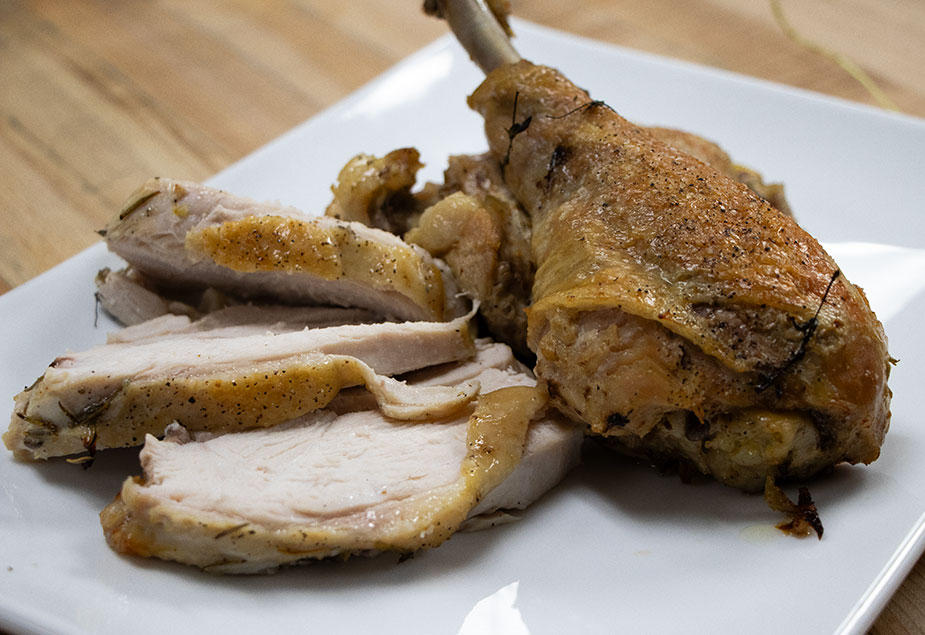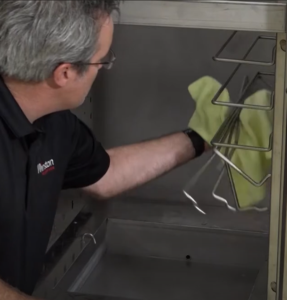
In this blog, our CEO, Shaun Tanner, cooks a confit turkey, resulting in the most amazingly moist turkey we have ever had.
I’ve been thankful for having a CVap oven available to cook Thanksgiving dinner for over ten years. Throughout that time, my cooking methods continued to evolve. I started with a low-and-slow method, allowing a 165°F vapor to do most of the work and adding a bit of air heat to brown it.

I used seasoned butter between the skin and the meat, producing an outstanding balance of flavor and juiciness. A few years later, I wanted the meat to be even more moist, so I moved to a staging method. I set the vapor temperature in the CVap to 165°F -170°F, with no extra air heat. Then, right before we were ready to carve, I’d pull the bird out and throw it in a conventional oven that was running at 500°F. After about 15 minutes, the skin was beautiful and crispy, while the meat had all the moisture you could ever want. Up until this year, that’s the way that I’d recommend to everyone with access to a CVap oven to cook their Thanksgiving meal.

Confit Turkey this Year!
That is, until this year. I decided to try something new. I recognized that while I may have cooked the best turkey that anyone could want, the quality of the product out of the oven would decrease some while I was busy carving it. And I wondered if I could make the entire process easier without sacrificing flavor. Leveraging my knowledge of classical cooking methods, I wanted to see what would happen if I did a confit turkey.
What is Confit?
In case you’re not familiar with confit, it typically refers to a cooking method in which food, usually meat, is slowly cooked in fat at low temperatures. This method is often used for preserving and enhancing flavor. It was developed to preserve food before refrigeration became widely available. Submerging meat in the cooking fat creates a seal that prevents oxygen from reaching the food, stopping bacteria from growing.

Gathering Consensus
I brainstormed with a colleague who is also a chef, but he wasn’t as excited about the idea as I was. He asked me what was wrong with the staging method I’d used for years. I explained that this would allow me to break down the bird ahead of time into eight cuts, making it insanely easy to cut for slices. And it might result in a juicier product than what I’ve been doing. I think he saw the light after that. So, I called my mom and told her that I would cook the turkey differently this year. After a long argument (she does not accept change well), she agreed to let me do a test run at work and cook it for the family at Thanksgiving if (and only if) it turned out well. Spoiler alert: it was a home run.
Ingredients
Brine Ingredients
| 1 gallon | Water |
| 2/3 cup | Kosher or Sea Salt |
| 3T | Lemon Juice |
| 2T | Dried Rosemary |
| 1T | Dried Thyme |
| 3 ea | Bay Leaves |
| 1/2 ea | Large Sweet Onion |
| 1/4 cup | Honey |
| 2T | Minced Garlic |
| 2T | Whole Black Peppercorn |
| 1 ea | Turkey (whole) |
Confit Ingredients
| 1.5 gallon | Olive Oil |
| 1.5 gallon | Vegetable Oil |
| 3/4 head | Celery (cut into 2" long pieces) |
| 5-6 ea | Carrots (cut into 2" long pieces) |
| 1.5 ea | Large Sweet Onions (large dice) |
| 8-12 | Garlic Cloves |
| 1 bu | Sage (rough chop) |
| 1/2 bu | Rosemary (rough chop) |
| 1/2 bu | Thyme (rough chop) |
| 2T | Whole Black Peppercorn |
| 3 ea | Bay Leaves |




Method of Preparation
1. Mix all brine ingredients.
2. Break down a turkey into eight cuts and add to the brine. If you want to know how to break down a turkey (or chicken), that’s what YouTube is for. I’d remove the skin from the breast meat (setting it aside) and leave the skin on the other pieces. Refrigerate for 12-24 hours.
3. The night before, prep the confit ingredients (throwing them all in a 6” deep hotel pan). Note, instead of the three gallons of oil (olive and vegetable), you could always use chicken fat. It would probably taste even better, but it wouldn’t be cheap.
4. Remove the turkey pieces from the brine. Place the wings, legs, and thighs into the confit solution. Do NOT add in the breasts.
5. Cover the solution and put it into a preheated CVap oven with the vapor temp at 165°F and the air temp at 170°F. Allow to cook overnight.
Continue Cooking Confit Turkey
6. About five hours before you are ready to eat, add the turkey breasts to the confit solution and put them back into the oven.
7. The breasts will need about 4-4.5 hours to cook. They can stay in longer but lose some moisture after about the 6-hour.
8. Around 30 minutes before dinner, preheat another conventional oven to about 400°F -500°F.
9. Pull the thighs, wings, and legs out shortly before serving. Season and throw into the conventional oven to brown the skin. This is where I’d also take the large pieces of skin from the breast meat, lay them down flat on a sheet pan, season, and bake.
10. When the skin is crispy (about 10 minutes), pull out everything and get ready to eat.

We concluded that the breast meat was, without question, the best-tasting breast we had ever had. Someone said it was like Thanksgiving dinner in one bite. From my perspective, it was a brothy-tasting turkey that almost was like stuffing while being the moistest turkey I’d ever had. The legs and thighs were more like a traditional confit, falling off the bone (maybe too much for some).
Overall, it was a huge success. My favorite part was that it just made carving insanely easy. But the flavor was what put it over the edge for me.
The only real con had to do with managing the oil. I never like moving around a hotel pan full of hot oil, nor trying to throw it away. Outside of that, though, I will send them this blog the next time someone asks how I’m cooking Thanksgiving.

About the Author
Shaun Tanner is the President & CEO of Winston Industries and a trained chef. A graduate of Johnson & Wales, Shaun has been with Winston for over 20 years. Besides being highly skilled in the kitchen, Shaun is also a notorious practical joker.





